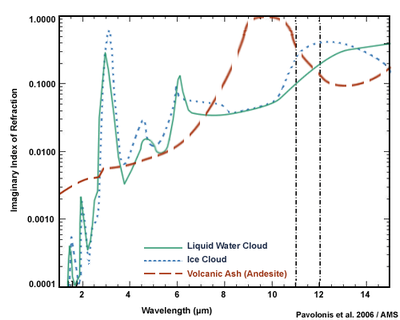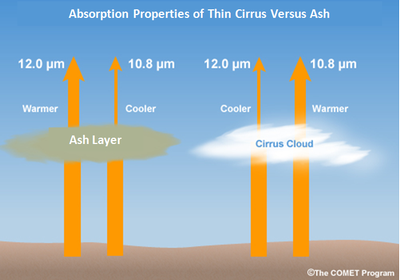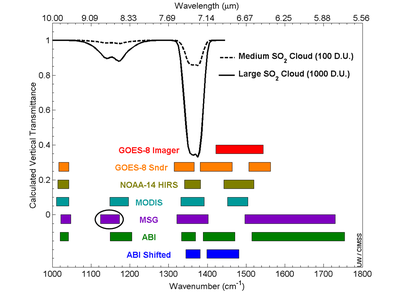The aim of the Ash RGB is to detect the three major volcanic emissions (ash, sulphur dioxide and ice crystals formed from water vapour) in distinct colours, allowing users to track their movements.
Physical basis
Detection of volcanic ash
Thick volcanic ash cloud is not separable from other thick clouds. However, the ash plume thins rapidly further from the source, and the semitransparent ash cloud is already detectable.
The key channel combination of ash detection is the (IR12.0-IR10.8) difference. This brightness temperature (BT) difference is negative for thin ice clouds and positive for thin ash clouds (see Fig. 1b). For thick clouds and cloud-free surface this difference is around zero.
| Figure 1a: Imaginary index of refraction for liquid water (solid green curve), ice (dotted blue curve) and volcanic ash (dashed brown curve) as a function of wavelength. (Source: http://www.meted.ucar.edu/EUMETSAT/products/print.htm ) |

|
| Figure 1b: Transmission through thin ash and thin ice clouds |

|
For semitransparent clouds the brightness temperature difference between two channels depends mainly on the difference of their spectral transparency: which wavelength is the cloud more transparent on. Ash particles absorb more radiation at 10.8 than 12 micrometers, while ice particles absorb less radiation at 10.8 than 12 micrometers, (see the dashed brown and dotted blue curves of Fig. 1a). Lower absorption means higher transparency, which means thin ice clouds are more transparent at 10.8 and thin ash clouds at 12 micrometers (see Fig. 1b). The (IR12.0-IR10.8) BT difference will be positive for thin ash and negative for thin ice clouds.
The (IR12.0-IR10.8) difference is particularly effective if the ash plumes
- are semitransparent (typically some distance downwind from the site of the eruption),
- reach high altitudes where the temperature difference between the ash cloud and the underlying surface is typically larger,
- contain small ash particles, and
- lack a significant number of water and ice particles.
Detection of volcanic sulphur dioxide gas plume
SO2 has a weak absorption band around 8.7 micrometers (see Fig. 2). The spectral bandwidth of SEVIRI IR8.7 channel is encircled. The (IR10.8 - IR8.7) BT difference allows one to detect pure volcanic SO2 plumes: the 10.8 channel is not affected by SO2 gas, while the signal measured by the IR8.7 channel decreases if the atmosphere contains SO2.
| Figure 2: Infrared transmittance of sulphur dioxide (SO2) plumes and the spectral bandwidth of the channels for some satellite sensors. (Source: CIMSS, University of Wisconsin and CSIRO) |

|
Detection of SO2 is more effective if
- the SO2 concentration is higher
- the temperature difference between the underlying surface and the SO2 plume is bigger
- the SO2 plume is pure. Mixed SO2, ash and ice clouds are difficult to detect because the (IR10.8 - IR8.7) difference is positive for SO2 gas plumes and negative for thin ash and thin cirrus clouds.